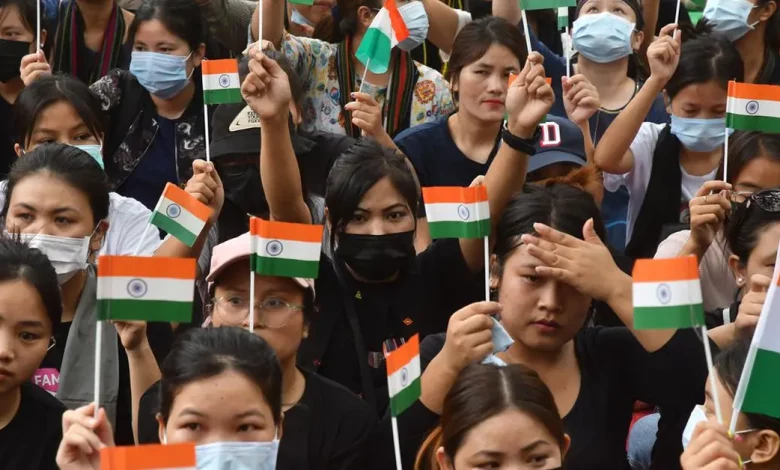
Context: The Union Government has instructed the Manipur State Government to review a request made by Maheshwar Thounaojam, the National Secretary of the Republican Party of India in Manipur, asking for the removal of specific Kuki and Zomi tribes from the Scheduled Tribes (ST) list of Manipur.
About:
- The decision comes after eight months of ethnic conflict between the Meitei people who live in the valley and the Kuki-Zo (ST) people who live in the hills.
- The conflict was sparked by a court order instructing the state government to recommend the inclusion of the Meiteis in the Scheduled Tribe (ST) list to the central government.
What factors contributed to the establishment of representation?
- However, a petition was filed to delete some of the tribes from the Schedule Tribes in Manipur as there is conflict between Meitei people and Kuki-zo(ST) tribe peoples.
- The Meiteis try to oppose some Kuki and Zomi tribes on the list since they claim possession of land in hill districts where only STs are allowed.
- This is the first time that the Meitei community has questioned ST status of other tribes and it will jeopardise special criteria for identification set out in 1965.
What is the main message of the representation?
- Mr Thounaojam, National Secretary of the Republican Party of India (Athawale) in Manipur, is challenging the inclusion of three specific tribes in Manipur’s Scheduled Tribe list.
- The claim is that these tribes are not indigenous to Manipur because they were not included in the pre-Independence Censuses.
- Representation implies that the integration of these tribes has contributed to undeserved benefits given to illegal immigrants from Myanmar and Bangladesh who are supposedly intended for Scheduled Tribes in India.
Claims and Arguments:
- The argument that certain tribes were not present in Manipur when the first Constitution list of Scheduled Tribes was created in 1950 has been disproven. The list included general entries for Kuki, Lushai, and Naga tribes.
- Although there is no evidence to support the claim that this inclusion has led to illegal immigration, the First Backward Classes Commission in 1955 recommended adding specific tribe names for Assam and Manipur, indicating a need for updated information.
- In 1956, the ST list for Manipur was revised to include 29 specific tribe names, except for Mizo (Lushai) Tribe, which was retained along with the Zou tribe.
- The representation questions why the First Backward Classes Commission did not make specific recommendations for these entries.
- The Lokur Commission in 1965 noted a division among Kuki tribes, leading to the addition of “Any Kuki Tribes” in the ST list in 2002-2003 to address identity concerns.
- However, the Bhuria Commission in 2002-2004 observed confusion and recommended mentioning specific tribe names in the ST list to prevent inter-tribe differences.
- The Lokur Commission addressed this argument by classifying tribes as larger groups with sub-tribes and synonyms.
Recent Developments:
- The Manipur Government has been directed by the Centre to reconsider a representation.
- The Chief Minister suggests the creation of a committee to investigate this matter.
- This representation may result in growing differentiation among communities within the State and make changes to STs classification criteria, particularly concerning Meiteis’ pursuit for SC status.
Some significant commissions or committees:
- The first Backward Class Commission, which was also known as the Kaka Kalelkar Commission came about through a Presidential Order in 1953. Under the chairmanship of Shri Kaka Kalelkar, it submitted its report in 1955.
- The Lokur Committee in 1965 put forward parameters for detecting a tribe, which included primitive features, special culture, people shutting themselves up from others along with foreigners.
- In 1995, The Bhuria Commission recommended incorporating some villages into the extension of panchayat raj for Scheduled Areas but it has not been implemented yet.
- In 2013, the Xaxa Committee was created to investigate socio-economic factors such as education and health arising from tribal communities and determine appropriate measures for their improvement.
Conclusion:
- The Kuki-Zomi tribes have been around for a long time and have different ways of living and beliefs.
- They are trying their best to overcome difficulties and make things better.
- It’s important for people to understand and appreciate their unique identities and traditions.
Source: TH
Practice question:
Q. Which tribal community is renowned for their skill in bamboo and cane crafts, as well as their traditional hornbill dance?
- Bodos
- Mizo
- Garo
- Konyak





.png)



